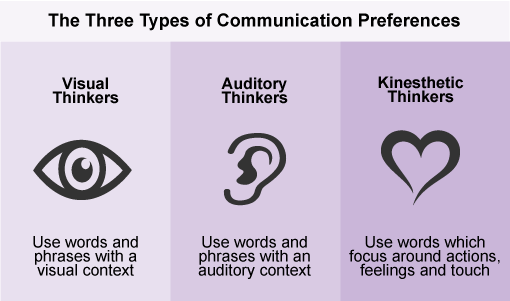There are two basic things that advisors need to think about when presenting options to customers: How much information is necessary? And which language choice best suits them?
The first question should be asked so that advisors know whether to provide information in big or small chunks to meet customer preferences.
The other can be a bit trickier, but highly skilled advisors may be able to determine which type of thinker the customer is and use sensory-specific language to build rapport.
Below is some helpful advice for using either big or small chunks of information and sensory-specific language to present options to customers.
Big Chunk / Small Chunk
Some customers only want a brief outline of the situation (a big chunk) and others want to know all the details (a small chunk).
Some customers only want a brief outline of the situation (a big chunk) and others want to know all the details (a small chunk).
Think about this: have you become bored in a conversation because the other person is providing far too much detail? Or frustrated because you weren’t provided with all the information you required?
In the contact centre, to develop a great rapport with someone, it’s beneficial for advisors to identify the “chunk preference” of the person they are communicating with.
But how can advisors find out what the customer’s preference is? Well, there are usually some clues:
- Does the customer talk in terms of details or are they providing an overview of the situation?
- Are they asking lots of specific questions to try and obtain more detail?
- Or perhaps they are prompting you to get to the point?
Spotting Big Chunk / Big Picture Customers
They like you to provide an overview in the first instance and avoid too much detail. These customers also tend to generalise.
For example, a “big chunk” customer is likely to make comments like:
“I haven’t received the Samsung Galaxy phone I ordered last week. Please can you tell me when I will receive it?”
Spotting Small Chunk / Detail Customers
They like detail, and specific next steps to follow. They check all the facts, dot the I’s and cross the T’s. They have longer attention spans than Big Chunk thinkers. They don’t like vague information or generalisations.
For example, a “small chunk” customer is likely to say something like:
“I’m calling to discuss the order I made last week for the Samsung Galaxy C8 in Gold. I made the order last Tuesday, I think it was around 2pm. I thought I would have received it by now as I’ve always received previous orders within 3 days. Please could you tell me what the problem is and exactly when I can expect to receive the order?”
Responding to a Big Chunk / Big Picture Customer
Once the advisor begins to realise that the caller is a “big chunk” customer, simply providing a general overview of the situation is all that is likely to be required. For example:
“Mr James, I’m very sorry about the delay. I’ve just been assured by the supplier that new stock has arrived, and the phone will be sent to you tomorrow 1st class recorded, as a matter of urgency. Will this be ok for you?”
Responding to Small Chunk / Detail Customers
Once the advisor begins to realise that the caller is a “small chunk” customer, it is good practice to go into the details of the situation, to boost rapport. For example:
“Mr James, I’m very sorry about the delay. I have looked into your order and can confirm there was a four-day delay with the supplier as they have received a large demand for this phone, particularly the Gold option. I’ve just contacted them for you and they have assured me that they have received an additional 500 phones in stock and your order will be sent out tomorrow. It will be sent 1st class recorded, as we know it’s a matter of urgency. Will this be ok for you?”
Remember
It should not be about the advisor’s personal preference, it’s about matching the customer’s communication preferences and creating rapport.
After all, it is important that advisors do not bore customers or leave them frustrated.
Sensory-Specific Language
There are three common types of communication preference: Visual, Auditory and Kinesthetic (VAK).

Visual Thinkers: Use words and phrases with a visual context, e.g. ‘I get the picture’ or ‘I see’
Auditory Thinkers: Use words and phrases with an auditory context, e.g. ‘That sounds great’ or ‘I’m lost for words’
Kinesthetic Thinkers: Use words and phrases which focus around actions, feelings and touch, e.g. ‘I’ve grasped that’ or ‘That doesn’t feel right’
The reality is that we all communicate with a mix of sensory language, but most people usually have a preference for one of them.
This is great to practise amongst the team, so when advisors are talking with one another, ask them to see if they can identify a preference.
If building rapport involves speaking the same language as your customer, then it’s beneficial to start listening for a sensory preference.
Examples of Spotting Different Types of Thinkers
A customer with a visual preference may say phrases such as: “Yes, I can see that option working for me.” Or “In light of what you have just told me, I’m still a little confused…”
A customer with an auditory preference may say: “That sounds like a better option.” Or “Let me tell you what I think, it all sounds very confusing…”
A customer with a kinesthetic preference may say: “The first option feels like that will work for me.” Or “I can’t get to grips with what you’re saying…”
Here are more words and phrases to help identify the customer’s sensory preference:
Words That Different Types of Thinkers Use
Visual Thinkers are likely to use some of the words/expressions that are highlighted below.
| Look | See | Pinpoint |
| Clarity | Appear | View |
| Show | Snapshot | Sight |
| Perceive | Light | Watch |
| Dawn | Reveal | Envisage |
| Clear | Vague | Foggy |
| Outlook | Focused | Hazy |
| Crystal | Inspect | Imagine |
| Picture | An eyeful | In view of |
| Mental picture | Paint a picture | Hazy idea |
| Plainly see | Get perspective | Eye to eye |
| Well-defined | Dim view | Looks like |
| See to it | Show me the bigger picture | Beyond a shadow of a doubt |
Auditory Thinkers are likely to use some of the words/expressions that are shown below.
| Hear | Listen | Sound(s) |
| Announce | Resonates | Remark |
| Speak | State | Babble |
| Echo | Speechless | Divulge |
| Tell | Talk | Tune in/out |
| I’m all ears | Rings a bell | As an afterthought |
| Loud and clear | Unheard of | Be heard |
| Tongue-tied | Utterly lost for words | Inquire into |
| Word for word | I’m dumbstruck | Pay attention to |
| State your purpose | Voice an opinion | Describe in detail |
| Clearly expressed | Clear as a bell | To tell the truth |
| Manner of speaking | Give an account of | Well-informed |
Kinesthetic Thinkers are likely to use some of the words/expressions that are presented below.
| Feel | Touch | Flow |
| Grasp | Hold | Catch on |
| Handle | Solid | Unsettling |
| Concrete | Smoothly | Stumbled |
| Muddled | Relaxed | Bearable |
| Cool | Hold on | Hang on a minute |
| Dragging me down | Tap into | Lay your cards on the table |
| Get a handle on it | Pull some strings | Break it down |
| Firm foundation | I’m not following you | Start from scratch |
| Walk me through | I don’t get it | I’m taking a firm stance |
| Boils down to | Get my drift | Get to grips with |
| Slipped my mind | I’ve got a gut feeling |
Responding to Different Types of Thinkers
One of the keys to building rapport is to mirror the customer’s choice of language, as this will demonstrate commonality between the advisor and customer.
So, if the advisor realises that the customer is a visual thinker, they should try to include some of the words and phrases included in the visual grid, to portray themselves as a visual thinker also.
For example, an advisor could try to reply to each different customer types, using statements similar to those specified below.
For a Visual Thinking Customer:
- “I’m so glad that this is looking like a good option for you.”
- “I’m very sorry, Mr Evans, let me see if I can explain it in a different way, so that it’s clearer. I do understand it’s a lot of information to take in.”
For an Auditory Thinking Customer:
- “I’m so pleased that this sounds useful for you”
- “I am sorry that I have caused confusion, Mr Jones. I want you to be well informed before you make a decision. What if I talk you through the main features of both options. Would that be more helpful?”
For a Kinesthetic Thinking Customer:
- “That’s fantastic, Mrs Jones, I’m so pleased that I’ve found an option which feels like a good solution for you.”
- “I’m so sorry, Mrs Smith, let me break the key information down for you, so that you’ve got a good grasp of what the benefits of each option are.”
Conclusion

Jacqui Turner
By using these two ways of presenting options to customers, advisors can enhance their communication skills and build a stronger rapport with customers.
Using these in customer service enables advisors to give the right amount of information while “shaping” language in the best interests of the customer.
Once the team know how to do this, the contact centre can even take it one step further and teach advisors about filtering, to ensure they are speaking in the same language as the customer.
Thanks to Jacqui Turner at Turner Corner Learning Solutions for sharing this article with us.
For more questioning techniques to improve customer service, read our articles:
- Call Control Techniques: Controlling a Runaway Talker on the Telephone
- 10 Effective Questioning and Probing Techniques for Customer Service
- Training Cheat Sheet – Effective Questioning
Author: Robyn Coppell
Reviewed by: Megan Jones
Published On: 19th Feb 2018 - Last modified: 14th Aug 2025
Read more about - Skills, Call Handling, Jacqui Turner, Language, Rapport, Skill Development





































